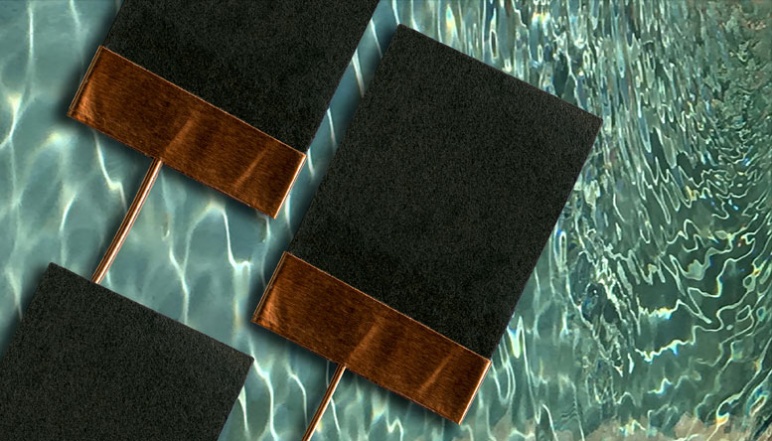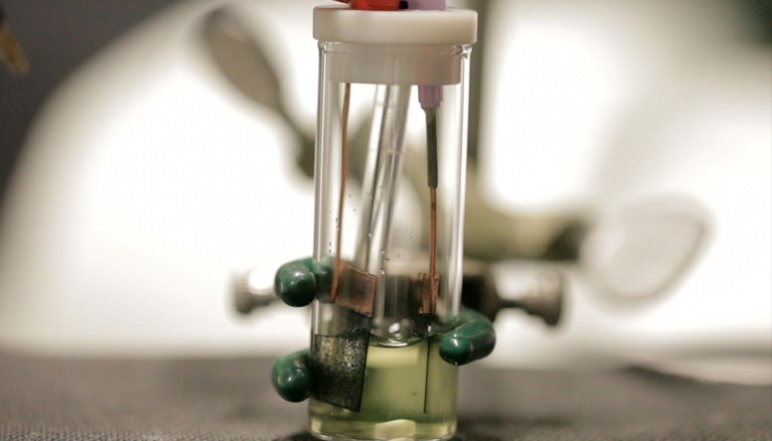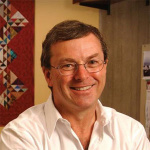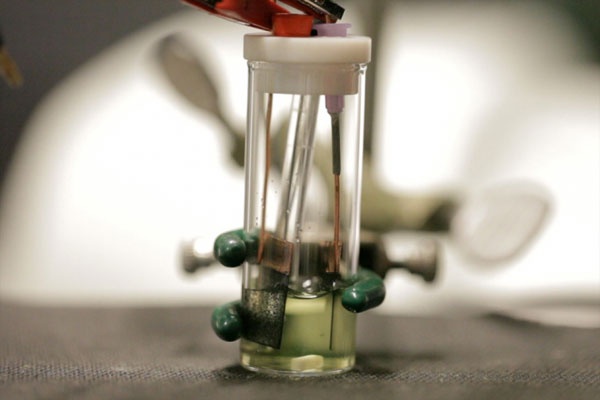Our Research Electrochemically-mediated adsorptive processes for water-remediation

Pads of Faradaic material floating in water. Image credit: Hatton research team

Vial with electrical source and chemically treated electrodes. Image credit: Hatton research team
A team of MIT researchers has developed a new way to clear pollutants from water, even when present in extremely low concentrations. Video: Melanie Gonick/MIT Electrode images: Felice Franke
Principal Investigator
T. Alan Hatton
- Ralph Landau Professor
- David H. Koch School of Chemical Engineering Practice Director
- Department of Chemical Engineering
T. Alan Hatton is the Ralph Landau Professor in the Department of Chemical Engineering. Professor Hatton's research interests include transport phenomena and separation processes, among others. Professor Hatton is the recipient of a 2015 J-WAFS seed grant for his project, "Electrochemically-modulated Separation Processes for the Treatment of Contaminated Water Sources," and a J-WAFS Solutions project, "Electrochemically-mediated Adsorptive Processes for Water-remediation."
Challenge:
Harmful micropollutants are not easily removed by current water filtration technologies. Is there an effective solution that can selectively remove these contaminants?
Research Strategy
- Engineer electrodes to target a variety of micropollutants
- Optimize operating conditions to minimize energy consumption with maximum contaminant removal
Project description
Efficient, affordable and robust purification technologies are needed for a range of separation contexts, from point-of-source treatment or remote in-situ purification devices to large-scale, centralized waste water treatment facilities. Chemical pollutants in ultra-dilute concentrations (micropollutants, e.g. organic endocrine disruptors, pesticides, household chemicals, dyes and heavy metal cations), classified by the EPA as contaminants of emerging concern pose a particularly vexing problem in wastewater treatment. Current technologies suffer from high energetic penalties and performance limitations when confronted with pollutants at these very low concentrations (nM to μM) in an excess of competing species. This research group has developed an electrochemically-assisted, chemically tunable, highly selective, and inexpensive platform technology that exploits nanostructured electrodes to selectively remove harmful contaminants at the nano-to micro-pollutant level, modulated solely by electrical potential and with no need for chemical regenerants. During the J-WAFS Solutions grant, they have worked on three-fold approach (i) designing and constructing a small-scale flow-cell for demonstration, (ii) improvement of the materials chemistry and robustness of the electrodes up to 500 cycles, and (iii) targeting practical wastewater conditions. The main goals in the second half of the project were to: (a) finalize the testing of the current flow-device and scale up the system towards a multi-electrode device, to get closer to commercialization; (b) decrease chemical costs of electrode manufacturing and improve robustness for >1,000 cycles and (c) through engagement with customers and outreach, find collaborators in industry and tailor our device and technical parameters to narrow our market application, including high-value added products and upstream purification. The J-WAFS Solutions funding boosted the research team’s commercialization level across all fronts, both technologically but also especially through providing connections with catalysts, partners and potential team members.
The main project objectives have remained the same as the initial J-WAFS Solutions proposal, with a focus on prototype development, materials chemistry improvement, and testing. Minor modifications on technical approach were a result of data acquired during the reporting period.
Outcomes
- Developed an electrochemically-assisted, chemically tunable, highly selective, and inexpensive platform technology that removes harmful contaminants at the nano-to micro-pollutant level
- Designed and constructed a small-scale flow cell for demonstration, improved the materials chemistry and robustness of the electrodes, and targeted practical wastewater conditions
- Identified key sales-channel partners and companies in the market for long-term subscription service contracts, and buy-own-operate strategies
Publications
Electrosorption at functional interfaces: from molecular-level interactions to electrochemical design
Xiao Su and T. Alan Hatton, Physical Chemistry Chemical Physics, 2017
Redox-electrodes for selective electrochemical separations
Xiao Su, T. Alan Hatton, Advances in Colloid and Interface Science, 2017
Asymmetric Faradaic systems for selective electrochemical separations
Xiao Su, Kai-Jher Tan, Johannes Elbert, Christian Ruttiger, Markus Gallei, Timothy F. Jamison & T. Alan Hatton, Energy & Environmental Science, 2017
Electrochemically mediated reduction of nitrosamines by hemin-functionalized redox electrodes
Xiao Su, Lev Bromberg, Kai-Jher Tan, Timothy F. Jamison, Lokesh P. Padhye, T. Alan Hatton, Environmental Science & Technology Letters, 2017
Selective molecularly mediated pseudocapacitive separation of ionic species in solution
Demetra S. Achilleos and T. Alan Hatton, ACS Applied Materials & Interfaces, 2016
Anion-selective redox-electrodes: electrochemically-mediated separation with heterogeneous organometallic interfaces
Xiao Su, Heather J. Kulik, Timothy F. Jamison, T. Alan Hatton, Advanced Functional Materials, 2016
News
Additional Details
Impact Areas
- Water
Research Themes
- Water Purification & Desalination
- Technology & Commercialization
Year Funded
- 2016
Grant Type
- Solutions Grant
Status
- Completed


